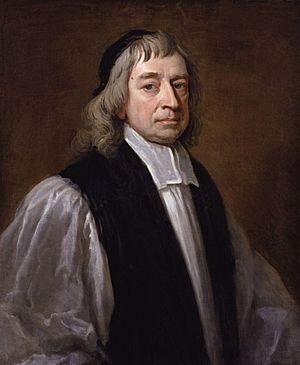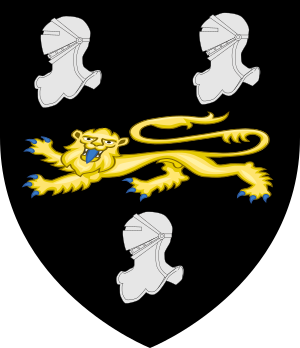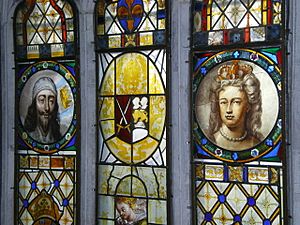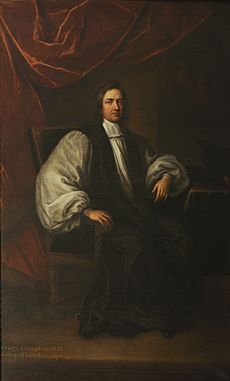Henry Compton (bishop) facts for kids
Quick facts for kids The Right Reverend and Right Honourable Henry Compton |
|
|---|---|
| Bishop of London | |

Portrait by Godfrey Kneller (1712)
|
|
| Church | Church of England |
| Diocese | Diocese of London |
| Appointed | 6 December 1675 |
| In Office | 1675–1713 |
| Predecessor | Humphrey Henchman |
| Successor | John Robinson |
| Orders | |
| Consecration | 6 December 1674 by Gilbert Sheldon |
| Personal details | |
| Born | 1632 Compton Wynyates, Warwickshire, England |
| Died | 7 July 1713 Fulham, London, England |
| Buried | All Saints Church, Fulham |
| Nationality | English |
| Denomination | Anglican |
| Parents | Spencer Compton, 2nd Earl of Northampton Mary Compton (née Beaumont) |
| Previous post | Bishop of Oxford (1674–1675) |
| Alma mater | The Queen's College, Oxford |
Henry Compton (born around 1632, died July 7, 1713) was an important English leader. He started as an army officer, then became a clergyman in the Church of England. He is best known for being the Bishop of London from 1675 until his death.
Henry Compton's Early Life and Education
Henry Compton was the sixth and youngest son of the 2nd Earl of Northampton. He grew up in a noble family.
Compton's Education Journey
He first studied at The Queen's College, Oxford. He left in 1654 without a degree. After that, he traveled around Europe.
From Soldier to Clergyman
When King Charles II returned to power in 1660, Henry Compton joined the army. He became a cornet, which was a junior officer, in his brother Charles's cavalry troop. However, he soon left the army to join the church. He continued his studies at Cambridge and again at Oxford. He earned his Doctor of Divinity (D.D.) degree in 1669. He then held several church positions, including rector of Cottenham and Witney.
Henry Compton's Career as a Bishop
Henry Compton became the Bishop of Oxford in 1674. The very next year, he was moved to the important position of Bishop of London. He also became the Dean of the Chapel Royal. This meant he was in charge of the royal chapel.
Teaching the Princesses
Compton was also made a member of the Privy Council. This was a group of advisors to the king. He was given the important job of educating the two princesses, Mary and Anne. Both of them would later become queens of England.
His Views on Protestants
Henry Compton was very open-minded for his time. He wanted to bring different Protestant groups back together with the main Church of England. He held meetings with clergy in his area to discuss this. He even got letters from famous foreign Protestant leaders to help convince people.
The Compton Census
In 1676, Lord Danby asked Compton to count the population for the church. This count became known as the Compton Census. It helped leaders understand how many people lived in different areas.
Standing Up to King James II
Compton was strongly against Roman Catholicism. When James II became king in 1685, Compton lost his place on the Privy Council. He also lost his job as Dean of the Chapel Royal. This happened because he refused to suspend a clergyman named John Sharp. Sharp had been preaching against the King's Catholic beliefs. For his strong stand, Compton was suspended by the King's special commission in 1686. However, his suspension was lifted in September 1688.
The Glorious Revolution
During the Glorious Revolution, Compton supported William III and Mary II. He was one of the "Immortal Seven" who invited William to invade England. When William and Mary became king and queen, Compton performed their coronation ceremony. The Archbishop of Canterbury at the time felt he was still loyal to James II, so Compton stepped in.
Later Years and Achievements
Compton remained a member of the Privy Council during Queen Anne's reign. He also helped arrange the terms for the union of England and Scotland. This act joined the two countries into Great Britain. He hoped to become the Archbishop of Canterbury, the highest position in the Church of England, but he was passed over twice. Henry Compton died in Fulham on July 7, 1713. He was buried at All Saints Church, Fulham.
Henry Compton's Published Works
Besides his church work, Henry Compton was also a successful botanist. This means he studied plants. He also wrote and translated several books. These included:
- A Translation from the Italian of the Life of Donna Olympia Maladichini (1667). This book was about a woman who influenced the Church during the time of Pope Innocent X.
- A Translation from the French of the Jesuits' Intrigues (1669).
Images for kids





